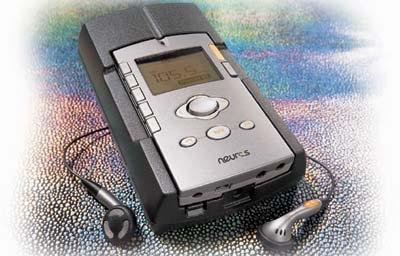The Cutting Edge: Neuros HD MP3 Player

On one hand, the company's Neuros players incorporate the vintage technology of FM radio. This not only lets you tune in and listen to broadcast music - you can also record songs off the air (in MP3 format) and then "broadcast" these or any other stored tunes to nearby FM radios. On the other hand, the Neuros players harness a clever new system called digital fingerprinting with an ingenious extension called HiSi (for "Hear it. Save it."). Whenever you hear an unfamiliar piece of popular music, you can save a 30-second clip, then later upload it to the Neurosaudio Web site so the song title and artist can be identified.
The two Neuros players are identical except for memory type and capacity. The Neuros ($249) has 128 megabytes of flash memory and plugs into a "backpack" containing a rechargeable battery, while the Neuros HD ($399) connects to a larger backpack (the dark part in the photo above) that also contains a 20-gigabyte (GB) hard-disk drive. Though the Neuros doesn't have a card slot to expand memory, you can upgrade to an HD backpack for $179. You could even alternate backpacks depending on whether you were more interested in traveling light or carrying plenty of music.
For our review, Digital Innovations sent us the Neuros HD, which includes earbud phones, AC and car power adapters, a USB cable (USB 1.1 is supported), and Synchronization Manager software on a 3-inch CD-ROM. To use the software, you'll need a PC running Windows 98SE or higher.
Once installed, the software can search your computer's hard drive for MP3 files and list them for potential export to the Neuros player. You'll need your own ripping software, though, if you want to convert CD tracks into MP3s. It took me about 16 minutes to transfer 112 tunes, encoded mostly at 128 kilobits per second (kbps), using the USB port. Speedier USB 2.0 transfer rates are not supported.
Incidentally, each Neuros is designed for use with one PC. Trying to add more tracks by installing the software on another computer could render previously transferred tracks inaccessible, which is what happened to me when I tried using both a desktop and notebook computer with it. Entering the date and time in the player's setup menu affords the benefits of time-date stamping your recordings and being able to leave your wristwatch at home.
Physically, the Neuros HD measures (WxHxD) 3 x 5¼ x 1¼ inches with backpack and weighs 9¾ ounces. (Attached to its smaller backpack, the basic Neuros is slightly smaller and weighs a little less than 6 ounces.) People accustomed to the diminutive standards set by Apple's iPod may be disappointed to hear that the Neuros HD is larger and weighs 50% more. Still, I found that its battery was good for about 8¼ hours, a little less than the 10 hours claimed in the manual. This compares with the 6 hours I got from the original iPod when I tested it a year and a half ago (Apple also claims 10 hours).
Moreover, the Neuros offers a range of extra capabilities including FM playback, digital fingerprinting, and stereo recording in MP3 format from the radio, a line-level input, or a built-in microphone- without a computer! The iPod isn't designed to do any of that. Then again, the iPod can still get by on good looks alone.
Holding down the play button on the Neuros turns on the backlit 1¾-inch monochrome LCD. You can listen to music transferred from your computer, a recorded FM program, or live FM. There are hard buttons for five station presets and an orange record button. Double clicking the record button will save the radio program currently playing at a data rate of 64, 96, 128, or 160 kbps. (The same choices are also available for recording from the line input or mike.) I found live and recorded broadcasts indistinguishable at 128 kbps even with the strongest stations.
- Log in or register to post comments



































































